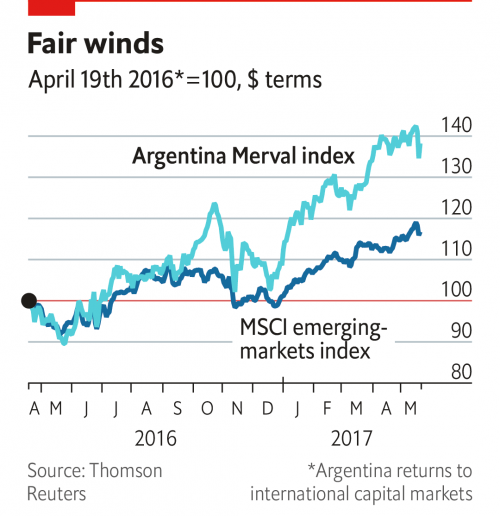Over the course of the last year, investors poured billions of dollars into emerging markets, seeking higher yields and higher overall returns. Emerging markets have rewarded that trust, and as things are shaping up, it would not be surprising if emerging markets continue performing well, surpassing the returns of developed markets. Some emerging markets in particular performed exceptionally well, and if reforms continue, then such good performance may also continue. One example is the Argentinean market, which as shown below since last April has well-outperformed the Emerging Markets Index.
What investors saw in the Argentinean case were serious reform efforts that undermined waste, advanced productivity, and improved the bottom line.
Another case which might pleasantly surprise us in the next year could be the Egyptian market. Three weeks ago, the Egyptian government passed an investment law that allows speedy one-stop shop approvals for new businesses (rather than dealing with 50+ agencies which was the typical case). The law provides substantial tax incentives, allows tax-free enterprise zones, while the average 600+ days for licenses is estimated to drop to about 30 days. When we take into account the passage of the bankruptcy law a few months ago, the floating of the currency last November, and budgetary reforms passed at the end of 2016, then we could see that the large Egyptian market and the low labor cost could attract investments, capital, buyouts, acquisitions, and increased market sentiment.
At the same time we see that the MSCI – the index provider – seriously contemplates to include the Saudi market into its index of emerging markets, given the reforms that the Saudi market is undergoing. If such review starts next month, then effective 2018 or 2019, the KSA could be the recipient of billions of dollars of funds seeking higher returns in the local market.
The above cases reflect a possible shift in the gravity of capital flows. However, at the same time we may be in the middle of a paradigm shift in consumer preferences. I am referring of course in the significant decline of traditional shopping purchases from malls and shops, and the corresponding significant increase in online shopping (e-commerce). Such paradigm shift could resemble the deindustrialization that many developed nations have experienced. The effects would be felt in employment (in the US 16 million people work in the retail sector), in commercial property values, in the companies’ finances, in tax collection, not to mention on the debt and the creditors. Total debt related to retailers and retailers’ real estate properties is estimated to be over $1.1 trillion. If some of it goes bad (as it is projected to be) and at the same time the student loan market starts experiencing higher default rates, then we may be into the dancing floor of a shift where we will be printing human hearts while contemplating artificial intelligence and data analytics from a lounge chair on the banks of the Nile.
What is that which can possibly disrupt the disruptors while shaking up the global threat called debt?

